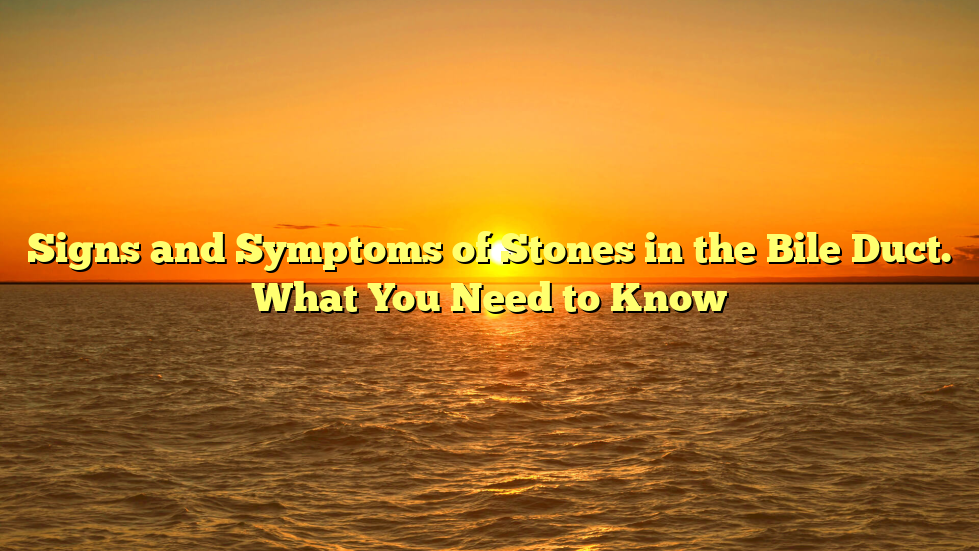Stones in the bile duct can cause various health complications and discomfort. In this blog post, we will explore the signs and symptoms that may indicate the presence of stones in the bile duct. Understanding these signs is crucial for early detection and appropriate medical intervention. So, let’s dive into the topic and learn more about the signs you should be aware of.
See More Chicken Coop Sign
1. An Overview of the Bile Duct
Before we discuss the signs of stones in the bile duct, let’s first understand what the bile duct is and its role in our digestive system. The bile duct is a tube-like structure that carries bile, a digestive fluid produced by the liver, to the small intestine. Bile helps in the digestion and absorption of fats. When stones form in the bile duct, it can disrupt the normal flow of bile.
2. What Causes Stones in the Bile Duct?
To better understand the signs of stones in the bile duct, it’s essential to know what causes them. The most common cause of bile duct stones is gallstones that migrate from the gallbladder into the bile duct. Other causes include inflammation, infection, or tumors obstructing the bile duct. Now that we have a basic understanding let’s move on to the signs and symptoms.
See more Product at Memorial Sign World
3. Abdominal Pain and Discomfort
One of the primary signs of stones in the bile duct is abdominal pain. This pain usually occurs in the upper right side of the abdomen, where the bile duct is located. The pain can range from a dull ache to intense, sharp pain. It may come and go or be constant, depending on the size and position of the stone. This persistent pain should not be ignored and warrants further investigation.
4. Jaundice
Jaundice is another significant sign of stones in the bile duct. It is characterized by yellowing of the skin, eyes, and mucous membranes. When a stone obstructs the bile duct, it prevents the normal flow of bile, causing a buildup of bilirubin (a yellow pigment) in the body. Jaundice may also be accompanied by dark urine, pale stools, itching, and general weakness.
See More Memorial Sign World Articles:
- Signs and Symptoms of Gallbladder Stones. What You Need to Know
- Signs and Symptoms of Kidney Stones. A Comprehensive Guide
5. Nausea and Vomiting
Stones in the bile duct can lead to nausea and vomiting. The obstruction caused by a stone can disrupt normal digestion and cause food to remain undigested in the stomach, leading to feelings of nausea. Vomiting may occur as a result of severe pain or as a reflex action due to the blocked bile duct.
6. Fever and Chills
In some cases, stones in the bile duct can trigger an infection, leading to fever and chills. When a stone obstructs the flow of bile, it creates a stagnant environment that promotes bacterial growth. This can result in an infection known as cholangitis. Symptoms may include high fever, shaking chills, abdominal pain, and jaundice. Prompt medical attention is required if these symptoms are present.
7. Itching and Skin Rashes
As mentioned earlier, when bile flow is obstructed due to a stone in the bile duct, bilirubin builds up in the body. Elevated levels of bilirubin can cause itching and skin rashes. The itching can be localized or affect the entire body. If you notice persistent itching without any apparent cause, it’s important to consult a healthcare professional to investigate further.
8. Unexplained Weight Loss
Unexplained weight loss can be a sign of various underlying health conditions, including stones in the bile duct. When a stone blocks the flow of bile, it can disrupt normal digestion and absorption of fats. This can lead to malabsorption and subsequent weight loss. If you experience unexplained weight loss along with other symptoms mentioned above, it’s crucial to seek medical advice.
9. Back Pain
While abdominal pain is commonly associated with stones in the bile duct, some individuals may experience back pain as well. The pain may radiate from the upper right side of the abdomen to the back. This back pain can be sharp or dull and may worsen after eating fatty foods or during physical activity. If you have persistent back pain along with other symptoms, it’s advisable to consult a healthcare professional.
10. Conclusion
Stones in the bile duct can lead to various symptoms that should not be ignored. Abdominal pain, jaundice, nausea, vomiting, fever, chills, itching, unexplained weight loss, and back pain are some common signs that may indicate the presence of stones in the bile duct. If you experience any of these symptoms or suspect you may have stones in your bile duct, it’s crucial to seek medical attention for proper diagnosis and treatment.
Remember, early detection and intervention are key to managing stones in the bile duct effectively. By being aware of these signs and symptoms, you can take proactive steps towards maintaining your digestive health and overall well-being.
(Note. The above content is for informational purposes only and should not be taken as medical advice. Please consult with a healthcare professional for accurate diagnosis and treatment.)
#memorialsignworld, #memorialsignworldstore,#MetalMonogramSigns, #PetMemorialCanvas, #ChickenCoopSign/

